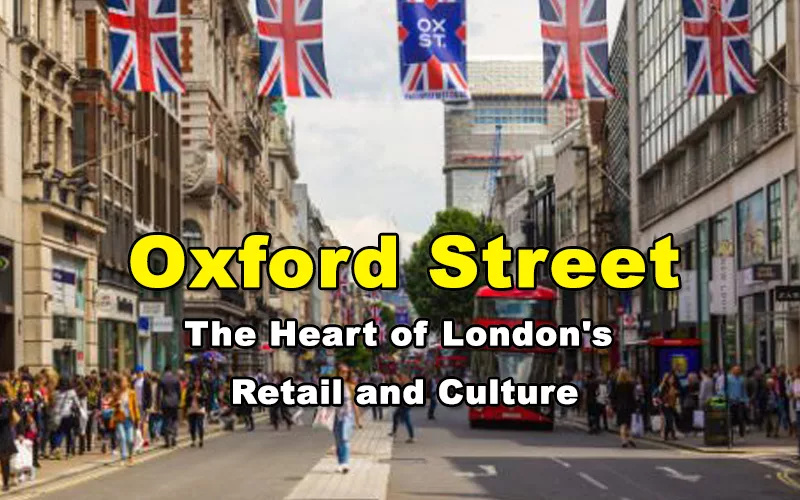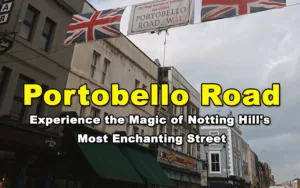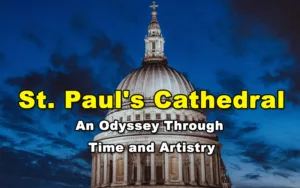Synonymous with shopping and bustling city life, Oxford Street is the epitome of London’s vibrant commercial and cultural heritage. Stretching over a mile and a half through the heart of the City of Westminster, it’s a bustling artery that pulses with the activity of over 300 retail shops, flagship stores, and iconic department stores like Selfridges. However, Oxford Street is more than just a retail hub; it’s a space where modernity intermingles with tradition, where cultural events enliven the atmosphere, and where the spirit of London is palpably felt with every step.
The significance of Oxford Street to London’s economy and tourism cannot be overstated. It is a major driver of economic activity, drawing shoppers and tourists from around the globe. Its unique blend of shopping experiences contributes substantially to the city’s retail economy, while its cultural events and historic charm are a major draw for tourists. The street is a vital employment hub, creating thousands of jobs, and its bustling activity is a testament to its role as a cornerstone of London’s economic vitality.
As one traverses the length of Oxford Street, they are met with a plethora of landmarks that echo the city’s rich historical narrative. Iconic establishments like the century-old Selfridges building stand as a testament to the area’s long-standing retail tradition.
The street’s history traces back to Roman times, evolving through the ages to become a reflection of London’s commercial and cultural zeitgeist. Its historical importance is interwoven with the fabric of London, marking it as a living chronicle of the city’s evolving identity. The allure of Oxford Street is further enriched by its notable landmarks, each narrating a chapter of London’s diverse and vibrant history, making it not just a shopping destination, but a journey through the annals of London’s legacy.
Historical Evolution of Oxford Street
The story of Oxford Street is a fascinating journey that begins in ancient times when it was known as a part of the Via Trinobantina, a Roman road that connected Essex and Hampshire. Over centuries, it evolved from a residential and later a retail hub in the 19th century to the modern-day commercial juggernaut it is now. Its transformation mirrored London’s own growth, transitioning from a humble beginning to becoming a significant part of the city’s urban landscape. The street’s name itself has historic roots, tracing back to it being a route to Oxford during medieval times.
The retail culture on Oxford Street blossomed in the late 19th and early 20th centuries with the establishment of department stores such as Selfridges and John Lewis, which soon became landmarks. The architectural landscape of Oxford Street evolved alongside its retail culture, with grandiose buildings housing major retail establishments, reflecting the prosperity and the modernization of the retail sector.
Over time, modern architectural designs have nestled themselves amidst historic structures, creating a visually stunning blend of old and new that characterizes Oxford Street’s unique charm.
Oxford Street has been a witness to numerous historical events and figures over the centuries. One notable figure is Harry Gordon Selfridge who founded the Selfridges department store in 1909, revolutionizing retail with his innovative marketing and customer-focused approach.
The street also bore witness to significant events, such as the protests of the 1960s and the bombings during the World War II era. Each event and individual associated with Oxford Street has contributed a layer to its rich historical tapestry, making it not just a commercial hub, but a living narrative of London’s diverse history. Through periods of peace and tumult, prosperity and adversity, Oxford Street has stood as a testament to London’s resilience and its ever-evolving narrative.
Retail Landscape of Oxford Street
Oxford Street is a shopper’s haven, brimming with a mix of stores to suit all tastes. It’s where big department stores like Selfridges, John Lewis, and Marks & Spencer steal the spotlight, offering a treasure trove of items. But it’s not just about the big guys; the street also boasts quaint boutique shops and go-to brands like Topshop and Primark, serving up both high-end and wallet-friendly choices.
This blend of shopping options makes Oxford Street a hit among both the locals and visitors. And with a variety of international brands lined up, it feels like a mini global shopping tour right in the heart of London.
When it comes to London’s economy, Oxford Street plays a big part. The street sees a sea of shoppers every year, contributing a significant chunk to the city’s retail sales. It’s also a major job hub, offering employment to thousands of people in the retail world. The presence of major stores and retail outlets attracts more business and creates a competitive, innovative environment that helps the retail sector grow. So, the bustling activity on Oxford Street is not just about shopping, it’s a reflection of how well the retail economy is doing in London.
Lately, there’s been a move to make Oxford Street more friendly for folks on foot. There are plans brewing to tone down the traffic, freshen up the air, and make strolling around a nicer experience for all. Thoughts of widening the sidewalks, carving out chill spots for pedestrians, and cutting down on car access during the rush hours are among the steps to make Oxford Street a safer and comfier place.
This change is all about juggling the needs of modern city life while keeping the quaint charm of Oxford Street intact, making sure it stays a beloved spot for shopping and just hanging out.
Cultural Significance of Oxford Street
Oxford Street isn’t merely a retail haven; it’s a cultural hotspot with venues like the London Palladium, known for hosting a myriad of theatrical performances and concerts, anchoring its cultural scene. The area surrounding Oxford Street is rich in galleries, theaters, and museums, making it a focal point for artistic and cultural exploration. Events such as the annual switching on of the Christmas lights, live music performances, and street entertainers contribute to the vivacious atmosphere, making Oxford Street a lively and engaging destination all year round.
The symbiosis between commerce and culture on Oxford Street is palpable. The retail establishments not only draw people for shopping but create an environment where cultural events can thrive. The influx of both locals and tourists drawn by the retail allure often find themselves immersed in the cultural festivities that Oxford Street hosts.
This interaction enhances the street’s identity, making it a place where commerce and culture coalesce, enriching the experiences of those who traverse its bustling sidewalks. The presence of historic retail edifices alongside modern shops symbolizes the harmonious blend of tradition and modernity, contributing to Oxford Street’s unique identity.
Among the notable events that epitomize the cultural essence of Oxford Street is the annual Christmas lights switch-on event. This tradition, spanning several decades, heralds the beginning of the festive season, transforming the street into a whimsical winter wonderland. The event often features celebrity appearances, live music, and a spectacular display of lights, drawing crowds from across London and beyond.
Besides, impromptu street performances by musicians and entertainers add a layer of cultural vibrancy, making every stroll down Oxford Street an enriching experience. These events and performances further the narrative of Oxford Street as a space where every visit holds the promise of a new, enriching experience, embodying the dynamic spirit of London’s retail and cultural scene.
Challenges and Future Prospects Related To Oxford Street
The retail and cultural sectors on Oxford Street have not been immune to challenges, notably the rise of online shopping and the effects of the COVID-19 pandemic. Online shopping has diverted a portion of consumer spending away from brick-and-mortar stores, prompting Oxford Street retailers to innovate and enhance the in-store experience.
The pandemic, with its social distancing measures and lockdowns, significantly impacted foot traffic and sales, while cultural venues faced closures and event cancellations. These challenges have spurred discussions on adaptive strategies to sustain Oxford Street’s vibrancy in a rapidly evolving retail and cultural landscape.
Several developments are on the horizon to ensure Oxford Street remains a premier destination. Plans to further pedestrianize the street, improve public transport access, and enhance the overall urban environment are aimed at promoting a more enjoyable and accessible experience.
Additionally, proposals for mixed-use developments, incorporating retail, residential, and cultural spaces, aim to diversify Oxford Street’s offering and ensure its sustainability. By adapting to modern consumer preferences and urban living standards, these developments aim to keep Oxford Street relevant and attractive to both locals and visitors.
The ripple effects of Brexit and other macroeconomic factors also loom over Oxford Street. Brexit-related changes in trade agreements and consumer spending patterns could impact the retail sector, while fluctuations in currency value might affect tourism and, consequently, retail and cultural revenues on Oxford Street.
Moreover, regulatory changes and economic policies post-Brexit could influence investment and development plans for the area. The intertwining of Oxford Street’s fortunes with broader macroeconomic dynamics underscores the importance of strategic planning and adaptability in navigating the uncertainties that lie ahead, ensuring the street’s enduring appeal and economic vitality amidst a changing socio-economic landscape.
Summing Up Oxford Street
Oxford Street is like a living storybook of London’s vibrant mix of shopping, culture, and history. Its story is told through its old buildings, the lively buzz of its shops, and the colorful array of cultural events. It’s more than just a shopping street; it’s a snapshot of London’s retail world and cultural heart. Oxford Street reflects the city’s journey, capturing the essence of what makes London, London. Every aspect of Oxford Street paints a picture of the city’s rich past, its buzzing present, and promising future.
There’s a saying that goes, “To know London is to love it,” and there’s no better way to get to know the city than by wandering along Oxford Street. Each visit is like opening a door to discovery, be it the newest fashion finds, an enchanting street act, or the simple pleasure of watching the city’s rhythm amidst its historical landmarks.
The charm of Oxford Street is timeless, welcoming everyone to dive into the many adventures it holds. So whether you’re all about shopping, a history buff, or on the lookout for some cultural vibes, Oxford Street is ready to give you a warm welcome and a taste of London’s lively spirit. A stroll down this iconic street is more than just a shopping spree, it’s a deeper dive into the rich and varied story that is London.
“I may earn commissions as an affiliate from sponsored links within this post”








